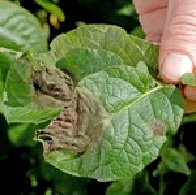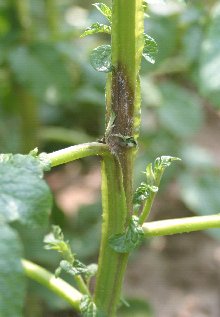Categories
Calendars
Guides
Reviews
Archive
Gallery
Articles
Ask Our Gardening Expert
Click here to set the weather dates to your area of the UK or USA.
![]()
Media
Information
Watch
Out for Potato Blight
Gardeners and allotment owners are being urged to be on
the look out for potato blight this summer, the disease that caused the Irish potato famines
in the 1840s. Experts say that more and more outbreaks of blight are originating from
allotments and gardens. These can spread to other gardens and allotments, but also affect
commercially grown potatoes.
Gary
Collins, Technical Executive with the Potato Council, said: �In the current climate more
people are growing their own potatoes. As potato blight is a major concern to the industry,
we keep a check on where outbreaks are coming from. Between 2007 and 2008 the number of
outbreaks from allotments and gardens more than doubled. Because potato blight can spread
very easily over large distances, everybody needs to keep a close eye on their potatoes.
Not only can it can reduce the quality of your home-grown crop, but also your
neighbour�s
crop, and the local farmer�s crop too. A little knowledge and effort can go a long way to
reducing the impact of this disease�
Blight is most likely to appear between July and
September, particularly when the weather is warm and humid. Gardeners should look out for
dark brown or blackish patches or lesions on the top of the leaflets [1], often surrounded
by a pale yellow halo. These lesions may also be found on the stems [2]. Under humid
conditions, there may be a downy white coating that looks like fine cotton wool developing
on the underside of the leaflets, or again on the stems. Blight spores released from this
white coating is how the disease spreads from the foliage to other plants, or down on to the
soil, where they can infect the tubers, causing sunken areas on the potato surface, and a
chestnut-coloured
rot under the skin.
If you discover what looks like potato blight you should
snip off the leaflets, or even whole stems to stop the disease spreading and remove them
from the crop. If vigilant, this may slow the spread to a point where the crop is unharmed,
and you will have done your bit to help reduce the spread of blight. The potatoes can still
be harvested after two to three weeks. Make sure you remove all the potatoes from the
ground, and do not leave any in the soil or on garden tips.
Tips for preventing blight include:
�
Always buy
your seed potatoes from a reliable source
�
Choose a
variety that is less susceptible to blight
�
Ridge the
soil well after planting your potatoes
�
Mulch to
reduce the amount of water required
�
Water the
soil and not the potato foliage
�
Harvest all
your potatoes � even the tiniest ones
[1]
[2]
To find out more about potato blight, visit
www.potato.org.uk/blight for an in-depth fact sheet. On this site, you can also register
free to receive weather warnings that let you know when the conditions are right for the
spread of blight - known as a Smith Period, or that there may be blight in your area. These
are sent by email and as a text message.
Ends
Note to editors
�
Potato Council is part of the Agriculture and
Horticulture Development Board
www.ahdb.org.uk working on behalf of British potato growers and purchasers to promote
potatoes. Potato Council is funded through a statutory levy on 3,000 potato growers and
potato trade purchasers and aims to support the British potato industry
�
Please below a Fact Sheet with more
information on blight.
�
Potato
blight is the most important potato disease.
�
Potato
blight is a fungal disease spread by spores.
�
Potato
blight is most likely to appear between July and September, when the weather is at its
warmest.
�
The signs of
potato blight are dark brown or blackish patches on the leaves, often surrounded by a pale
yellow halo. On the underside of the leaves there may be a downy white coating of spores in
moist conditions, particularly at night. These blight lesions may also be on the stems.
�
The blight
can spread from the foliage to the tubers, causing sunken areas of the potato, and chestnut
coloured rot under the skin.
�
Once blight
affects a plant, the infection can easily spread given the right weather conditions.
�
If the
weather is humid, the spores that spread blight can spread over long distances.
�
Between 2008
and 2009, the percentage of outbreaks of blight originating from allotments or gardens rose
from 3.6% to 9.1%.
�
Organisations such as Potato Council monitor conditions for periods when blight infection
can spread most rapidly. These are known as �Smith Periods�, and occur when there are at
least two consecutive days of temperatures of
10�C, and on each day there are 11 hours when
the humidity is greater than 90%. You can find more information and register for forecasts
at www.potato.org.uk/blight.
�
Gardeners
who discover potato blight should remove the affected leaves or stems to prevent blight
spreading to the potatoes. The earlier this is done the better. This will also stop the
spores spreading. This may reduce the number and size of the tubers growing on the stem
�
Tubers
should be harvested after two to three weeks, and may be unaffected.
�
Those
growing their own potatoes can take a number of steps to ensure that reduce the likelihood
of blight occurring:
o
Always buy
your seed potatoes from a reliable source. Do not bring seed potatoes from another country,
or save your own as they may be infected.
o
Some
maincrop varieties show some resistance and are slow to develop blight.
o
Always
remove all potential sources of blight. Harvest even the tiniest potatoes, and remove any
potatoes that grow by themselves (volunteers).
o
Never
abandon old tubers around the garden or allotment, or try to compost them.
o
Remove
blighted tubers before storing, and always store your potatoes under dark, cool conditions.
o
Avoid
planting in sheltered sites and plant in rows into the wind if possible.
o
If watering
is required apply to the base of the plants, soil improvement and mulching will reduce the
amount of watering required.
o
Blight
spores on foliage are washed down through the soil to infect tubers. Earthing up potatoes,
or mulching the soil with hay or straw can reduce levels of infection.
�
Potato
blight caused the Irish potato famines in the 1840s and led to widespread starvation.
Ends
CLICK
HERE FOR NEXT POTATO PAGE Name: ginny ![]()
Potato Council on Potato Blight



Potato Blight � The Facts
Potato
Home Page
Previous
Potato Page
E-mail: ginnymusic@yahoo.co.uk
Date posted: August 15, 2010 - 11:05 am
Message: Hi, I have discovered my entire crop of Nicola second earlies has potato blight. First plant "died" i thought last week. "nd yesterday and by last night every one of the 40 or so plants had shown the telltale leaves. Have dug up the entire lot today and harvested them. There were some plants with white cottony threads in the ground - looked a bit cobwebby. Some had clearly rotted soggy and largish potatos but other pots on the same plant were fine. Have saved the ok ones. Some ok ones had white spots like mould on which wipe off. These ok to eat?? Also found some half centimetre long white threadworm like creatures lurking with intent - are they related to the blight. Have read I should have waited before lifting the spuds after removing the tops -eek. What is the best thing to do - this is my first ever veg. on the plot after two years digging and ground prep. We have heavy clay soil and a lot of water from above - live in Devon!! Can I grow spuds on a different part of the same plot next year. Which might be better than Nicola and what should I do to prepare the soil. Can I grow other vegetables iminently on the soil I have just dug over. I think I have got all the spuds out but there are threadlike roots still in the soil. do I treat it first and then wait before planting something else. Have tried to stay off chemicals as want an "organic" plot if possible. If I have to use something to avoid infecting my plants next year I will. I would love some advice. Is there somewhere it would be helpful to record this incidence of blight for this area? Is there a central register of it each year?
Many thanks for your help. Sorry this is so long.